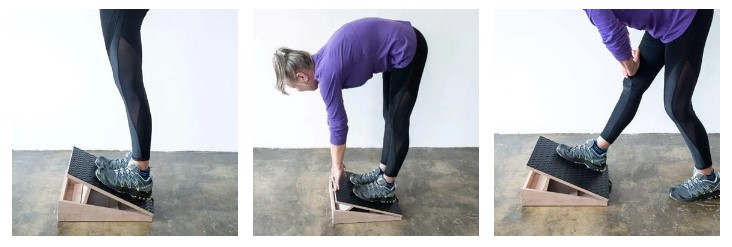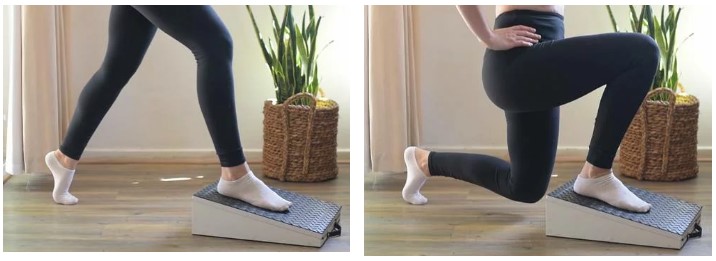Introduction
In the world of fitness and rehabilitation, innovation often lies in simplicity. One such unassuming tool that has gained significant traction among fitness enthusiasts, athletes, and physical therapists is the slant board. A slant board may appear as a mere inclined platform, but its applications range from improving strength and flexibility to aiding in recovery and injury prevention. Whether you’re a seasoned athlete or someone looking to alleviate chronic pain, incorporating slant board exercises into your routine can yield transformative results.

In this article, we’ll delve deep into the benefits, applications, and techniques of slant board exercises. Drawing from expert advice, personal experiences, and scientific research, we aim to provide a comprehensive guide that underscores the value of this versatile tool.
What Is a Slant Board?
A slant board is a flat surface set at an angle, typically made of wood or sturdy plastic, designed to assist in exercises that involve stretching, strengthening, and balance training. It is often adjustable, allowing users to customize the incline according to their fitness level or therapeutic needs.
Common Uses:
- Stretching and Flexibility: Ideal for calf stretches, hamstring stretches, and Achilles tendon lengthening.
- Rehabilitation: Essential for recovering from injuries like plantar fasciitis, Achilles tendinopathy, or knee surgeries.
- Strength Training: Perfect for exercises like squats and lunges to enhance muscle activation.
- Balance and Coordination: Supports balance drills for improving proprioception.
Benefits of Slant Board Exercises
1. Improves Ankle and Calf Flexibility
Tight calves are a common issue among runners and those who spend long hours on their feet. A slant board helps elongate the calf muscles and improve dorsiflexion—the upward flexing motion of your foot. Enhanced ankle flexibility reduces the risk of injuries like sprains and shin splints.
2. Enhances Knee Strength and Stability
One of the standout benefits of slant board exercises is their impact on knee health. Inclined squats performed on a slant board target the VMO (Vastus Medialis Oblique) muscle, critical for stabilizing the knee joint. This is particularly beneficial for individuals with patellar tendinopathy or post-ACL surgery.
3. Promotes Better Posture
Working on an inclined surface encourages the correct alignment of the spine, hips, and lower limbs. Over time, this helps in alleviating back pain and correcting postural imbalances.
4. Aids in Injury Prevention and Recovery
By targeting often-neglected muscle groups and improving joint mobility, slant board exercises significantly lower the risk of injury. Additionally, they are instrumental in rehabilitation programs, speeding up recovery and restoring function.
5. Boosts Athletic Performance
Athletes rely on strong, flexible lower limbs for optimal performance. Regular use of a slant board improves explosive strength, agility, and endurance by enhancing the functional strength of the legs and core.
6. Improves Balance and Stability
Balance is a critical aspect of overall fitness, often overlooked in traditional training. Slant board exercises challenge stabilizer muscles, improving coordination and proprioception, which are essential for activities ranging from yoga to high-impact sports.
7. Supports Overall Mobility
The increased range of motion achieved through slant board exercises benefits not only the lower limbs but also enhances overall body mechanics, making everyday movements more efficient and pain-free.

Popular Slant Board Exercises
1. Calf Stretch
- How to Perform: Stand on the slant board with your heels off the edge. Keep your legs straight and lean forward slightly.
- Benefits: Improves calf muscle flexibility and alleviates tightness.
- Tips: Hold the stretch for 20-30 seconds and repeat 2-3 times.
2. Inclined Squats
- How to Perform: Stand on the slant board with feet shoulder-width apart. Perform a squat while keeping your chest upright and knees tracking over your toes.
- Benefits: Activates the VMO muscle, strengthens quads, and reduces knee strain.
- Tips: Start with a low incline and gradually increase it as you progress.
3. Hamstring Stretch
- How to Perform: Sit on the floor with your legs extended and feet placed on the slant board. Reach forward to touch your toes.
- Benefits: Enhances hamstring flexibility and relieves lower back tension.
- Tips: Avoid bouncing during the stretch to prevent muscle strain.
4. Ankle Dorsiflexion Drill
- How to Perform: Place one foot on the slant board with the knee bent and drive it forward over your toes while keeping the heel grounded.
- Benefits: Improves ankle mobility and reduces stiffness.
- Tips: Perform 10-15 controlled repetitions per leg.
5. Single-Leg Balance Drill
- How to Perform: Stand on the slant board on one foot and try to maintain balance for 30 seconds.
- Benefits: Enhances proprioception and strengthens stabilizer muscles.
- Tips: Use a wall for support initially if needed.
6. Nordic Hamstring Curls
- How to Perform: Kneel on a padded surface, anchor your feet under a sturdy object, and use the slant board for controlled forward movement.
- Benefits: Strengthens the hamstrings and reduces the risk of strain or injury.
- Tips: Maintain a slow, controlled motion to engage muscles effectively.
7. Lunges
- How to Perform: Place your front foot on the slant board and perform a lunge, ensuring your knee stays aligned with your toes.
- Benefits: Targets quads, glutes, and hamstrings while improving joint stability.
- Tips: Alternate legs and perform 10-12 reps per side.
My Personal Experience with Slant Board Exercises
As someone who has battled chronic knee pain from years of playing basketball, the slant board has been a game-changer in my recovery. Incorporating inclined squats and calf stretches into my routine not only reduced my discomfort but also improved my overall leg strength. Initially, the exercises felt challenging, but consistency paid off. Within weeks, I noticed increased mobility and reduced stiffness in my joints.
Another instance where the slant board proved invaluable was during my friend’s recovery from Achilles tendinopathy. Using the slant board for eccentric heel drops under a physiotherapist’s guidance accelerated healing and restored his confidence in returning to sports.

Expert Insights on Slant Board Training
Physical Therapists:
“Slant boards are invaluable in rehabilitation. They allow for controlled stretching and strengthening, making them ideal for patients recovering from lower-limb injuries.” — Dr. Emily Carter, DPT
Fitness Trainers:
“Using a slant board during strength training engages muscles differently, providing a unique stimulus that can break plateaus and enhance performance.” — John Michaels, Certified Personal Trainer
Sports Scientists:
“The angled surface of a slant board helps distribute force evenly during exercises, reducing strain on joints and optimizing muscle activation.” — Dr. Laura Green, PhD in Exercise Science
Choosing the Right Slant Board
Features to Look For:
- Adjustable Angles: Versatility for different exercises.
- Non-Slip Surface: Safety during use.
- Sturdy Material: Durability under heavy loads.
Recommended Products:
- StrongTek Professional Slant Board
- Yes4All Adjustable Slant Board
- PhysioRoom Wooden Slant Board
Tips for Safe and Effective Slant Board Use
- Warm-Up First: Always start with a 5-10 minute warm-up to prepare your muscles.
- Progress Gradually: Begin with a lower incline and shorter durations before increasing intensity.
- Focus on Form: Maintain proper alignment to avoid strain.
- Listen to Your Body: Stop immediately if you feel pain or discomfort.
- Incorporate Variety: Combine slant board exercises with other training methods for comprehensive fitness.
Incorporating Slant Board Exercises into Your Routine
For Beginners: Slant Board Exercise
- Start with basic stretches like the calf and hamstring stretch.
- Use the slant board 2-3 times a week.
For Advanced Users: Slant Board Exercise
- Combine slant board exercises with weighted squats and lunges for added intensity.
- Perform dynamic drills like jump squats for plyometric training.
For Rehabilitation:
- Follow a physiotherapist’s guidance to ensure safe and effective recovery.
- Focus on low-impact exercises and gradually increase intensity.
Conclusion
The slant board may be a simple tool, but its versatility and effectiveness make it a must-have for anyone aiming to enhance their physical fitness or recover from injuries. From improving flexibility and strength to supporting rehabilitation, its benefits are backed by both science and anecdotal evidence.
Start small, stay consistent, and make the slant board a part of your fitness journey. Whether you’re aiming for pain relief, better performance, or simply a more flexible body, the slant board is your ally. Remember, the path to better health and fitness begins with informed choices and small steps—or in this case, small inclines.
Ready to take the leap? Invest in a slant board and experience the difference today!

FAQ
1. What is a slant board used for?
A slant board is primarily used for stretching, strengthening, balance training, and rehabilitation. It helps improve flexibility, reduce injury risk, and enhance athletic performance.
2. Can beginners use a slant board?
Yes, beginners can use a slant board by starting with low-incline stretches and gradually progressing to more challenging exercises.
3. Is a slant board exercise good for knee pain?
Absolutely. Slant board exercises, like inclined squats, target the VMO muscle, which is crucial for knee stability and can alleviate knee pain.
4. How often should I use a slant board?
For general fitness, 2-3 times a week is sufficient. For rehabilitation, follow your physical therapist’s recommendations.
5. Can I make a slant board at home?
Yes, you can create a DIY slant board using wood or other sturdy materials, ensuring it’s stable and has a non-slip surface.
6. Are there any risks to using a slant board?
If used improperly or excessively, slant boards can cause strain or discomfort. Always focus on proper form and progress gradually.
7. Who should avoid using a slant board?
Individuals with severe joint issues or specific medical conditions should consult a healthcare professional before using a slant board.
Explore Our Recipes


